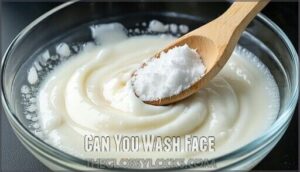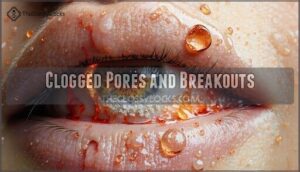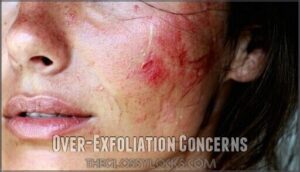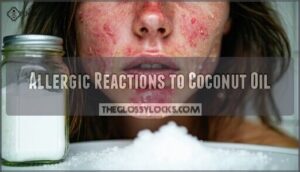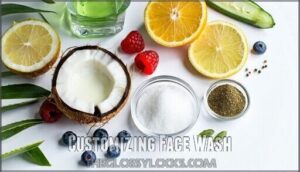This site is supported by our readers. We may earn a commission, at no cost to you, if you purchase through links.

This DIY combo offers natural exfoliation through baking soda’s fine crystals while coconut oil provides antibacterial benefits and moisture.
However, baking soda’s alkaline nature can disrupt your skin’s pH balance, potentially weakening its protective barrier.
Coconut oil may also clog pores in some people, leading to breakouts.
The mixture works best when used twice weekly for most skin types, though sensitive skin needs gentler alternatives.
Success depends heavily on your specific skin type and proper ratios.
Getting the technique right makes all the difference between glowing results and irritated skin.
Table Of Contents
- Key Takeaways
- Face Washing Benefits
- Can You Wash Face
- Mixing Coconut Oil
- Potential Skin Risks
- Customizing Face Wash
- Frequently Asked Questions (FAQs)
- How to use coconut oil & baking soda?
- How do you use baking soda & coconut oil scrub?
- Can you use baking soda on the face?
- How to use honey & coconut oil to clean your face?
- Can coconut oil & baking soda help with acne?
- How do you use baking soda & coconut oil scrub?
- How to use honey & coconut oil to clean your face?
- How to use coconut oil & baking soda?
- Is coconut oil and baking soda good for skin?
- Can I use baking soda to wash my face?
- Conclusion
Key Takeaways
- You can use this mixture safely, but timing matters – Limit use to twice weekly, maximum, to avoid over-exfoliation and skin barrier damage from baking soda’s alkaline properties.
- Your skin type determines the right ratio – Oily skin needs a 1:1 coconut oil to baking soda ratio, while dry or sensitive skin requires a 3:1 ratio for gentler cleansing without irritation.
- Watch for warning signs during use – Stop immediately if you experience redness, burning, or breakouts, as baking soda can disrupt your skin’s natural pH balance and cause lasting damage.
- Patch test before committing to the routine – Test the mixture on your forearm first to identify potential allergic reactions or sensitivity issues before applying it to your face.
Face Washing Benefits
You can wash your face with coconut oil and baking soda, but this combination requires careful consideration of your skin type and proper technique.
The mixture offers natural exfoliation through baking soda’s gritty texture while coconut oil provides moisturizing benefits and antimicrobial properties.
Natural Exfoliation Properties
Baking soda’s fine crystals act as a gentle physical exfoliant when you mix them with coconut oil for facial cleansing.
Gentle crystals buff away dead skin while coconut oil nourishes—nature’s perfect exfoliating duo
Transform your skin naturally with this powerful duo that buffs away dullness while deeply nourishing.
This natural ingredient synergy promotes healthy skin cell turnover by removing dead cells that can’t shed naturally.
You’ll find this exfoliation frequency works well twice weekly for most skin types, though gentle alternatives may suit sensitive complexions better.
Consider long-term effects when establishing your routine, and remember the importance of healthy skin.
Balancing Skin PH Levels
Your skin maintains its natural Acid Mantle through a delicate pH balance, and this coconut oil-baking soda blend can disrupt those Ideal Levels.
Disrupting your skin’s pH balance can weaken its natural protective barrier overnight
Baking soda’s alkaline nature creates PH Imbalance, while coconut oil provides Natural Buffering properties for your Skin Microbiome during facial cleansing.
Some cleansers use soothing oat extract to reduce irritation.
Three pH disruption risks:
- Alkaline shock – Your skin’s protective barrier weakens rapidly
- Microbiome chaos – Beneficial bacteria struggle to survive harsh conditions
- Irritation cascade – Redness and sensitivity follow pH disruption
Antibacterial and Antifungal Effects
Beyond surface cleaning, your coconut oil face wash delivers powerful antimicrobial protection.
Coconut oil’s lauric acid naturally fights bacterial resistance while targeting fungal infections that cause breakouts.
This natural facial cleanser maintains your skin’s microbial balance without harsh chemicals.
For acne treatment and sensitive skin care, these natural remedies offer gentler skin protection than conventional products, helping prevent common skin issues naturally.
Moisturizing and Nourishing Skin
Beyond tackling harmful bacteria and fungi, you’ll discover that coconut oil’s moisturizing powers work wonders for your skin barrier.
This natural facial cleanser delivers deep hydration importance through healthy fats that support nutrient absorption.
Your DIY skincare routine benefits from coconut oil’s nourishing properties:
- Locks in moisture – Natural oils create a protective seal
- Restores skin barrier – Essential fatty acids repair damage
- Boosts healthy glow – Deep hydration reveals radiant skin
- Enhances absorption – Prepares skin for other skincare products
Can You Wash Face
Yes, you can wash your face with a coconut oil and baking soda mixture when you follow proper ratios and techniques.
This DIY cleanser requires careful preparation to avoid skin irritation and maximize benefits for your specific skin type, using a mixture that is well-prepared.
Ideal Ratios for Different Skin Types
Finding the right balance starts with understanding your skin’s unique needs.
Oily skin ratios work best at 1:1 coconut oil to baking soda for deeper cleansing, while dry skin ratios need 3:1 for gentler care.
Sensitive skin ratios require the mildest 3:1 blend with honey added, and Combination skin ratios typically use 2:1 for balanced results.
Mature skin ratios benefit from 3:1 with fractionated coconut oil for this natural facial cleanser, which can be effective but also poses risks.
However, be aware that baking soda’s high pH can disrupt the skin, potentially leading to increased skin irritation, and cause skin irritation.
Proper Mixing Techniques
Creating your mixture requires careful attention to ingredient order and tool selection for ideal results.
Start with coconut oil at room temperature, then gradually add baking soda while mixing slowly to achieve proper texture consistency.
Use a small spoon for tool selection, creating small batch sizes to maintain freshness.
This homemade face scrub combines coconut oil benefits with baking soda’s cleansing properties for effective skincare.
Storage and Shelf Life
Once mixed, your homemade skincare blend requires careful handling to maintain effectiveness.
Store the mixture properly to preserve coconut oil benefits and baking soda for skin properties.
Essential storage guidelines for your natural ingredients mixture:
- Container Type – Use airtight glass jars to prevent moisture absorption
- Storage Temperature – Keep below 76°F to maintain coconut oil’s stability
- Expiration Dates – Use within 2 weeks for maximum potency
- Opened vs. Unopened – Fresh batches last longer than stored mixtures
- Ingredient Degradation – Watch for color changes or unusual odors indicating spoilage
Adding Essential Oils for Enhanced Benefits
You can enhance your coconut oil face wash with therapeutic properties by adding essential oils like tea tree or lavender.
Use safe dilution ratios – typically one drop per tablespoon of carrier oils. Different oil combinations create unique scent profiles while providing targeted benefits.
Many people find essential oils effective for skincare.
Always patch test new natural ingredients before applying to your entire face during your baking soda face cleanse routine, using essential oils.
Mixing Coconut Oil
Now you’ll create the perfect coconut oil-baking soda mixture for safe face cleansing by following specific preparation steps.
You’ll need to measure ingredients carefully and blend them properly to avoid skin irritation while maximizing the cleansing benefits.
Preparing Your Skin for Cleansing
Start your pre-cleanse routine by removing makeup with gentle cleansing tools or micellar water.
Rinse your face with lukewarm water to open pores and improve skin hydration. Pat dry with a clean towel, leaving skin slightly damp.
This facial cleansing method prepares your complexion for the coconut oil face wash and baking soda face cleanse mixture, maximizing the oil cleansing method’s effectiveness.
Coconut oil’s benefits include reducing inflammation and moisturizing skin.
Applying The Mixture Correctly
Apply your coconut oil and baking soda mixture using gentle upward strokes across your face.
Start with clean hands and work the paste onto damp skin using circular motions. Keep the mixture thickness consistent – it shouldn’t be too runny or too thick.
Focus on your T-zone where oil buildup occurs most. This application frequency works best 2-3 times weekly for ideal facial cleansing results, yielding the best outcome with gentle upward strokes.
Massaging Techniques for Optimal Results
Once you’ve applied the coconut oil and baking soda mixture, proper massaging techniques release its cleansing potential.
Use these methods for superior washing face results:
- Circular motions – Work in small circles across your entire face, focusing on pressure points
- Upward strokes – Move from jawline toward temples to support lymphatic drainage
- Tool usage – Consider a soft facial brush for enhanced cleansing
These facial care routines maximize the mixture’s effectiveness.
Exploring different facial massage products can further enhance your routine.
Rinsing and Removing The Mixture
After thorough facial cleansing, lukewarm water temperature works best for rinsing without irritating skin.
Gently splash water across your face, ensuring complete residue removal from all areas.
Pat skin with a clean towel—no rubbing that damages delicate tissue.
Frequency rinsing depends on your skin’s tolerance, but most people benefit from this cleaning method twice weekly maximum for ideal aftercare routine results.
Potential Skin Risks
While coconut oil and baking soda can offer skin benefits, this combination isn’t risk-free for everyone.
You should understand the potential side effects before adding this DIY mixture to your skincare routine.
Skin Irritation and Sensitivity
You’ll want to watch for signs your skin can’t handle this combo.
Baking soda’s alkaline nature disrupts your skin’s protective barrier, while coconut oil may trigger contact dermatitis in sensitive individuals.
Using baking soda can substantially alter your skin’s natural skin pH.
Patch testing helps identify potential irritants before full application, preventing painful reactions like redness or burning that compromise barrier repair.
Clogged Pores and Breakouts
Coconut oil’s comedogenic properties can occasionally trigger clogged pores and breakouts, especially if you’re prone to acne.
The oil’s molecular structure may block pore cleansing pathways, creating ideal conditions for acne triggers.
When combined with baking soda, this mixture can disrupt your skin’s natural balance, potentially worsening blackhead removal efforts and compromising whitehead prevention through inadequate pore size management.
Over-Exfoliation Concerns
Baking soda’s abrasive nature can damage your skin barrier through excessive scrubbing.
Daily use strips natural oils, causing redness and irritation from product overuse.
Limit exfoliation frequency to twice weekly maximum.
Your skin needs time between sessions for repairing damage.
Gentle exfoliation works better than harsh facial scrubs for maintaining healthy facial exfoliation without compromising your protective barrier, and it supports the idea of gentle exfoliation.
Allergic Reactions to Coconut Oil
Beyond over-exfoliation, coconut oil itself poses allergy risks you shouldn’t ignore.
Identifying Allergens through Patch Testing reveals Cross-Reactivity patterns in 1-2% of tested individuals.
Reaction Symptoms include redness, swelling, and hives within 24-72 hours.
If you experience sensitive skin care issues, consider Treatment Options like antihistamines and explore alternative natural remedies for your skin care routine and beauty advice needs.
Customizing Face Wash
You can adjust the coconut oil and baking soda mixture to match your specific skin needs and concerns.
Different ratios and additional ingredients help create a customized face wash that works better for your unique skin type, allowing you to address your specific skin concerns.
Adjusting Ratios for Oily Skin
For oily skin types, you’ll need to adjust your coconut oil to baking soda ratio to 1:2 or 1:3.
This higher baking soda percentage helps absorb excess sebum while preventing pore congestion.
Start with a pea-sized amount of coconut oil mixed with one teaspoon of baking soda twice weekly, and monitor your oiliness severity to adjust cleansing frequency accordingly for ideal post-wash care results.
Modifications for Dry and Sensitive Skin
For dry and sensitive skin, you’ll want gentle ingredients that won’t strip your skin’s natural oils.
Lower your baking soda concentration to under 1% and use a 4:1 coconut oil ratio for reduced irritation.
Patch testing on your forearm helps identify reactions before applying to your face.
Consider soothing additives like colloidal oatmeal or aloe vera as hydration boosters.
Reduce frequency to twice weekly maximum for these natural beauty remedies.
Adding Honey for Extra Hydration
Honey transforms your coconut oil baking soda mixture into a hydrating powerhouse that won’t strip your skin’s natural moisture barrier.
This golden addition creates a gentler cleanse while delivering essential nutrients. As a bonus, you can explore the health advantages of this natural sweetener.
- Manuka honey offers superior antibacterial properties for problematic skin
- Raw honey provides maximum enzymes and natural humectants for deep hydration
- Mix 1 teaspoon honey per tablespoon of coconut oil for ideal consistency
- Apply with gentle circular motions to activate honey’s natural exfoliation
- Leave mixture on 2-3 minutes before rinsing for enhanced moisturizing benefits
Incorporating Tea Tree Oil for Acne-Prone Skin
Tea tree oil transforms your coconut oil and baking soda mixture into a powerful acne treatment for problematic skin.
Add just 2-3 drops per tablespoon of base mixture to avoid potential irritation on sensitive skin. This dilution ratio provides effective acne treatment benefits while maintaining gentle facial cleansing properties.
Remember that tea tree oil’s anti-inflammatory effects can help reduce redness.
Always patch test first, as tea tree’s antibacterial properties can cause reactions in some users seeking improved skincare results with effective treatment.
Frequently Asked Questions (FAQs)
How to use coconut oil & baking soda?
Mix equal parts coconut oil and baking soda to create a gentle face scrub.
You’ll massage it onto damp skin using circular motions, then rinse thoroughly with warm water for smoother skin.
How do you use baking soda & coconut oil scrub?
Combine equal parts coconut oil and baking soda to create a paste. Gently massage onto damp skin using circular motions for 30 seconds, then rinse thoroughly with warm water.
Can you use baking soda on the face?
You can use baking soda on your face, but proceed with caution. Its abrasive nature can irritate sensitive skin and disrupt your natural pH balance. Start with gentle, infrequent use.
How to use honey & coconut oil to clean your face?
Research shows 70% of people over-cleanse their faces, damaging their natural barrier.
Gently massage equal parts raw honey and melted coconut oil onto damp skin for thirty seconds, then rinse with lukewarm water for naturally clean, moisturized skin.
Can coconut oil & baking soda help with acne?
Coconut oil shows promise due to its antimicrobial properties, but baking soda disrupts your skin’s natural pH balance, potentially causing more harm than good for acne.
Using a natural skin remedy can be complex, given the potential benefits and drawbacks of these ingredients.
How do you use baking soda & coconut oil scrub?
Gently mix equal parts coconut oil and baking soda until you’ve created a smooth paste.
Massage this mixture onto damp skin using circular motions for thirty seconds, then rinse thoroughly with lukewarm water.
How to use honey & coconut oil to clean your face?
Mixing honey with coconut oil creates a gentle, natural cleanser that removes dirt while moisturizing your skin.
Apply the mixture in circular motions, let it sit briefly, then rinse with warm water for soft, clean skin.
How to use coconut oil & baking soda?
You can combine coconut oil with baking soda to create a gentle exfoliating face scrub.
Mix one tablespoon coconut oil with one teaspoon baking soda, massage onto damp skin, then rinse thoroughly with lukewarm water.
Is coconut oil and baking soda good for skin?
Like mixing fire with water, combining these ingredients creates potential skin chaos.
Coconut oil moisturizes effectively, but baking soda’s alkaline nature can disrupt your skin’s natural pH balance, causing irritation and dryness.
You’re better off using them separately for safer results.
Can I use baking soda to wash my face?
You can use baking soda to wash your face, but it’s risky. Baking soda’s high pH can disrupt your skin’s natural barrier, causing irritation, dryness, and sensitivity. Consider gentler alternatives.
Conclusion
Like a skilled gardener who knows that even the most beneficial fertilizer can burn delicate plants when misapplied, you must approach washing your face with coconut oil and baking soda with careful consideration.
This natural combination offers genuine benefits through gentle exfoliation and antibacterial properties, but success depends entirely on proper technique and frequency.
You can wash your face with coconut oil baking soda effectively when you respect your skin’s individual needs and limitations.
Start slowly, monitor your skin’s response, and adjust accordingly.
Remember that natural doesn’t automatically mean gentle—your skin’s health should always guide your skincare choices.

